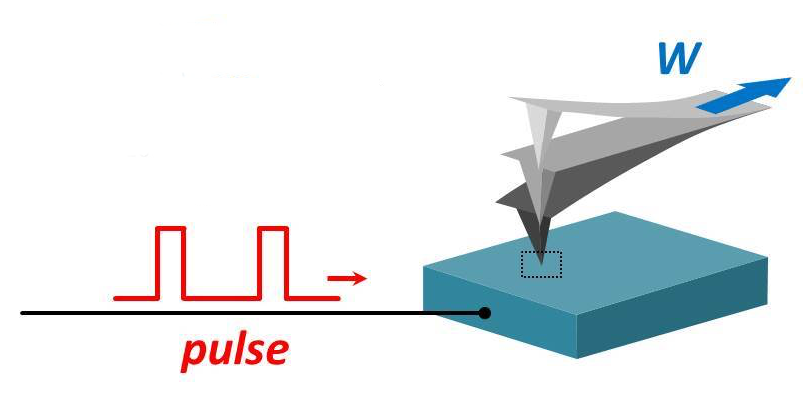Pulses Give New Force to Probe Microscopy
Atomic force microscopy (AFM) uses a pointy probe or “tip” to image a surface with atomic resolution, but the technique can also measure tiny forces between the tip and surface. A team has now developed an AFM method that measures the electrostatic force between charges on the tip and those in the surface in a more direct and accurate way than previous techniques. The researchers apply a voltage pulse to the surface, which produces an additional electric field. Then they measure the work done by the electric field on the tip. The more accurate force measurement could improve studies of exceedingly weak forces, like those from gravity or from the (quantum mechanical) Casimir effect.
By measuring the electrostatic force at the nanoscale, physicists can study, for example, the charge distribution around dopants in semiconductors [1], light-induced processes in organic solar cells [2], or bonding sites on molecules [3]. In these experiments, an AFM tip is brought close to a surface, and a voltage is applied, causing opposite charges to accumulate in the two objects. The resulting electrostatic force affects the frequency at which the tip oscillates up and down above the surface.
To measure the force strength, researchers typically monitor a shift in the oscillation frequency as they vary the tip voltage and the tip-to-surface distance. The problem with this technique is that it doesn’t measure the absolute force but only the amount that it changes with distance (the gradient). So this technique only provides an accurate force value if the force drops to zero at large distances. But the electrostatic force can still be significant at relatively large tip-surface separations because the surface resembles an infinite plate of charge from the tip’s vantage point. By neglecting this large-distance contribution, gradient-based methods can have force measurement errors as high as 50%, says Yoshiaki Sugimoto of Osaka University in Japan.
Sugimoto and his Osaka colleague Eiichi Inami have devised a new method that measures the electrostatic force directly through the work it does on an AFM tip. The team first drove their tip with an oscillating voltage to vibrate it at a constant frequency and amplitude. They then applied a short voltage pulse at a moment when the tip was moving away from the surface. The pulse generated a sudden increase in the electrostatic force, putting a brake on the tip’s upward motion. The resulting drop in kinetic energy was observable as an increase in the power demand of the drive system as it struggled to maintain the tip’s oscillation amplitude. The energy loss is equivalent to the electrostatic work on the tip, and work is force times distance. So the researchers could determine the electrostatic force by simply dividing out the distance the tip traveled during the voltage pulse.
The team performed several experiments with different platinum-covered tips above surfaces of silicon, copper, and titanium oxide. They determined the electrostatic force and showed that it did not go to zero at relatively large distances of around 25 nanometers. As a check on their method, the researchers showed that their force measurements could be used to estimate the tip shape parameters, such as the radius of the tip’s pointy end.
An accurate electrostatic force measurement allows researchers to explore relatively smaller forces, like the Casimir and gravitational forces. In the case of gravity, the force is known to vary as one over the distance squared, “but it has not been verified at millimeter, micrometer, and nanometer distance ranges yet,” Sugimoto says. If a discrepancy were found in an AFM experiment, that could imply the existence of extra spatial dimensions, beyond the three we are familiar with.
Pavel Jelinek from the Institute of Physics of the Czech Academy of Sciences says there is a large effort to find new probe techniques for the electrostatic force at small scales. The method by Inami and Sugimoto “allows precise determination of the electrostatic force as a function of tip-sample distance and applied voltage,” making it superior to current practices, Jelinek says. However, he foresees potential challenges with the new technique, in demonstrating atomic resolution and in distinguishing the electrostatic effect from other energy loss mechanisms.
This research is published in Physical Review Letters.
–Michael Schirber
Michael Schirber is a Corresponding Editor for Physics Magazine based in Lyon, France.
References
- Rachel A Oliver, “Advances in AFM for the electrical characterization of semiconductors,” Rep. Prog. Phys. 71,076501 (2008)
- Rüdiger Berger, Anna L. Domanski, and Stefan A.L. Weber, “Electrical characterization of organic solar cell materials based on scanning force microscopy,” Eur. Polym. J. 49, 1907 (2013)
- Zhixiang Sun (孙志祥), Mark P. Boneschanscher, Ingmar Swart, Daniël Vanmaekelbergh, and Peter Liljeroth, “Quantitative Atomic Force Microscopy with Carbon Monoxide Terminated Tips,” Phys. Rev. Lett. 106, 046104 (2011)
More Information
Electrostatic force measurement techniques, from device company NT-MDT





